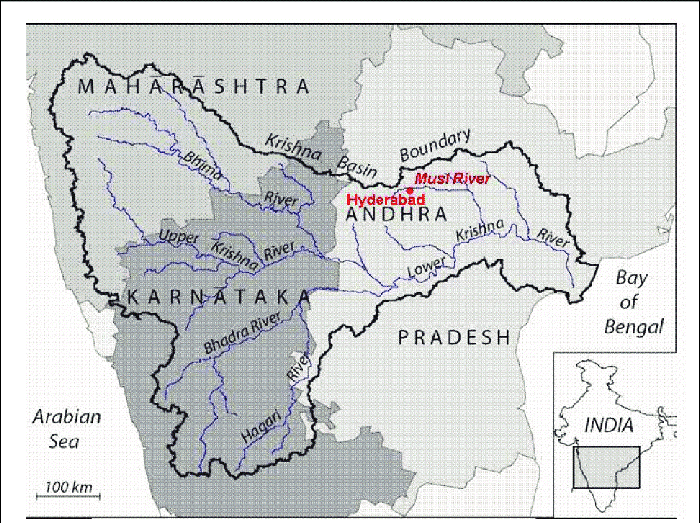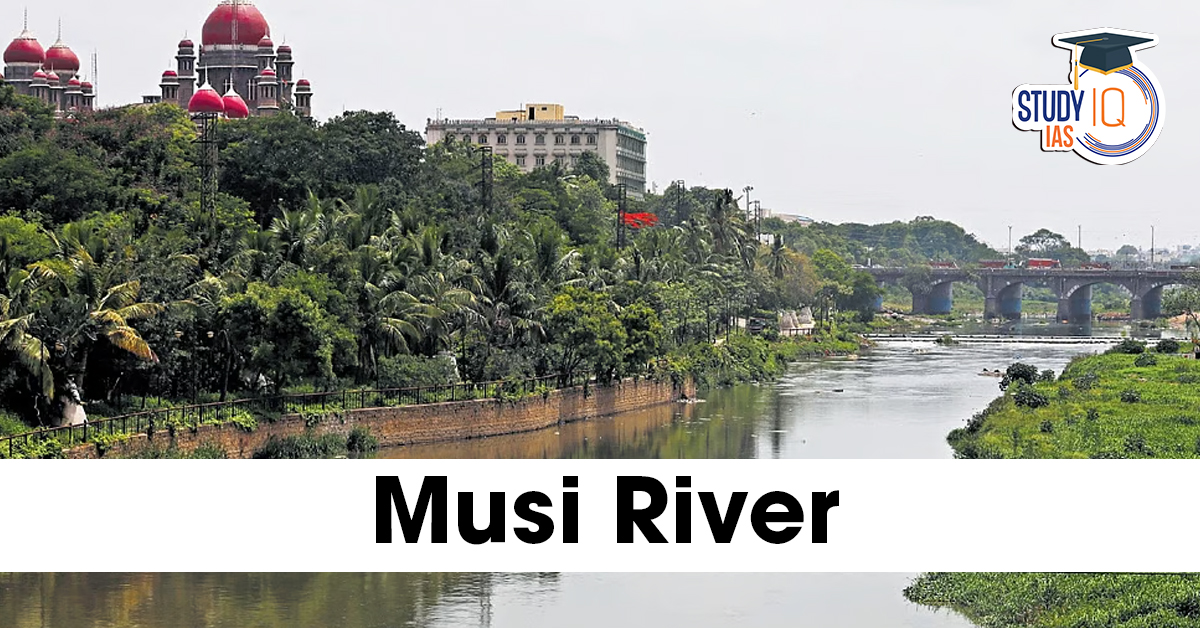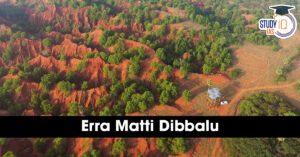Table of Contents
Context: HYDRAA (Hyderabad Disaster Response and Asset Protection Agency) reclaimed over 9.6 acres of the Musi river bed from illegal encroachments.
About Musi River
The Musi River, alternatively called Muchukunda or Musunuru River in the past, is a major Krishna River tributary in the Deccan Plateau, running largely in the state of Telangana, India. It bears a direct relation to Hyderabad, Telangana’s capital, as the city was established on its banks.
| Key Facts about Musi River | |
| Location | Flows through the southern Indian state of Telangana, on the Deccan Plateau. |
| Tributary of | Krishna River |
| Origin | Begins in the Anantagiri Hills near Vikarabad, in Rangareddy district, approximately 90 km west of Hyderabad. |
| Formation | Formed by the convergence of two small streams — Esi (8 km) and Musa (13 km). |
| Dams | Himayat Sagar, Osman Sagar |

Historical Significance of Musi River
- Great Musi Flood of 1908: The river was infamous for causing devastating floods in Hyderabad, the most catastrophic being on September 28, 1908. This flood, caused by 17 inches of rain in a single day, killed an estimated 15,000 people and destroyed vast parts of the city.
- Flood Control and Reservoirs: After the 1908 tragedy, the Nizam of Hyderabad (Mir Osman Ali Khan) appointed Sir M. Visvesvaraya to design a flood control system. This resulted in the creation of two large reservoirs across the Musi and its tributary:
- Osman Sagar (Gandipet): Constructed in 1920 on the Musi River, about 16 km upstream of the city.
- Himayat Sagar: Constructed in 1927 on the Esi, a tributary of the Musi.
These reservoirs effectively managed floods for decades and were the key sources of drinking water for Hyderabad.
- Heritage Buildings: Most of Hyderabad’s legendary historical buildings line the banks of the Musi, such as the Telangana High Court, State Central Library, Osmania General Hospital, and Women’s College (British Residency). The World Monuments Fund recently added these buildings to the 2025 World Monuments Watch list, citing a pressing need for their preservation in the face of environmental degradation.
Pollution and Environmental Degradation
Over the last few decades, the Musi River has undergone serious environmental degradation, especially as it runs through Hyderabad. It has mostly become a heavily polluted drain from what was once a clean river.
- Untreated Sewage: One of the main sources of pollution is the uncontrolled release of huge amounts of untreated or partially treated domestic sewage from Hyderabad’s fast-expanding urban centres.
- Industrial Effluents: Industrial waste, especially from chemical and pharmaceutical sectors, also finds its way in big numbers to the toxic cocktail of the river.
- Solid Waste Dumping: Massive quantities of municipal solid waste, plastic, and even animal cadavers are dumped into the river illegally.
- Encroachment: Encroachments along the river have reduced the capacity of the river and intensified flooding during rainfalls.
- Water Quality: Research (one of which was published in June 2025 in Cleaner Water) has repeatedly revealed alarmingly low levels of dissolved oxygen (DO), high Chemical Oxygen Demand (COD), Biochemical Oxygen Demand (BOD), and heavy metals, rendering the water unsuitable for consumption by human beings or aquatic organisms.
- Impact on Livelihoods: The pollution has killed fish populations, making fishing uninhabitable, and polluted groundwater, significantly affecting the health and livelihoods of downstream and riverbank communities, most notably farmers who depend on its water for irrigation.
Restoration Efforts for Musi River
Realising its dire condition, numerous governments have initiated programs for the rejuvenation of the Musi River.
- Musi Riverfront Development Project: The incumbent Telangana government, led by Chief Minister Revanth Reddy, has initiated a high-profile Musi Riverfront Development Project, planning it in the lines of the Sabarmati Riverfront in Ahmedabad.
- Unveiled with a huge budget increase (over ₹50,000 crore estimated), the proposal has:
- Development of several Sewage Treatment Plants (STPs) to treat wastewater before its discharge into the river.
- Ecological restoration activities.
- Development of infrastructure (e.g., East-West corridor, heritage bridges).
- Encroachment clearing and rehabilitation of impacted slum residents (a contentious element).
- The government has hired companies such as the Singapore firm Meinhardt Group for master planning.
- Unveiled with a huge budget increase (over ₹50,000 crore estimated), the proposal has:
- Previous Initiatives: Prior attempts and suggestions have also looked into natural, low-cost options such as bioremediation, bioengineering (for example, planting certain fish varieties or vetiver grass), and sponge city solutions, though experts at times lament the focus on mainly large infrastructure projects.
Restoration of the Musi River is a multifaceted, long-term issue that needs continued finance, technological intervention, strict enforcement of environmental policies, and most importantly, community involvement in bringing it back to its prime.


 Places in News for UPSC 2026 for Prelims...
Places in News for UPSC 2026 for Prelims...
 Lake Natron: Location, Features, Wildlif...
Lake Natron: Location, Features, Wildlif...
 Erra Matti Dibbalu Added to UNESCO Tenta...
Erra Matti Dibbalu Added to UNESCO Tenta...

























